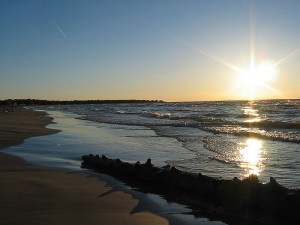There’s nothing more disappointing than heading to your favorite beach on a hot summer day, only to discover it’s closed. In 2010, the chance of that happening was about five percent of the time, according to the U.S. Environmental Protection Agency.
The EPA’s recently released beach report found that the nation’s beaches remained open 95 percent of the time during the summer swim season – a trend that’s been persisting for the past six years.
The report, which is available online, notes that 1,362 beaches had at least one closure in 2010. Out of 3,654 beaches monitored, that comes out to about 37 percent – or a little more than a third of the nation’s monitored beaches.
In 2010, the EPA found a total of 705,335 beach days within the swimming seasons of those beaches. The beaches were under an advisory or closed for 32,834 days, which comes to about five percent, the same as the last six years.

Ipperwash Beach, along Lake Huron. Photo via Wikimedia Commons.
The report doesn’t cover all beaches in the Great Lakes region. Michigan has 1,208 public beaches and 473 private beaches, according to that state’s Department of Natural Resources and Environment. The EPA report accounts for only 207 monitored beaches in the state.
Wisconsin has about 190 public beaches along Great Lakes shoreline, according to the Wisconsin Department of Natural Resources. Of that number, 113 are regularly monitored. For Minnesota, 39 beaches are monitored out of a total 79 Great Lakes shoreline public beaches. All 62 public beaches along Great Lakes shoreline in Ohio are regularly monitored.
Many of the causes for beach closure relate to stormwater runoff after a heavy rain, treatment plant problems or even animal waste. The report notes that more than 55 percent of the beach closures reported lasted no longer than a couple days.
Of particular interest to the Great Lakes region is the mention about the Great Lakes Restorative Initiative – $13.4 million in grants to be used specifically for beach-related activities from 2010 until 2014.
This year, the focus is on a project to make beaches safer, where the EPA expects to fund $8 million in an effort to reduce waste and sources of contamination.